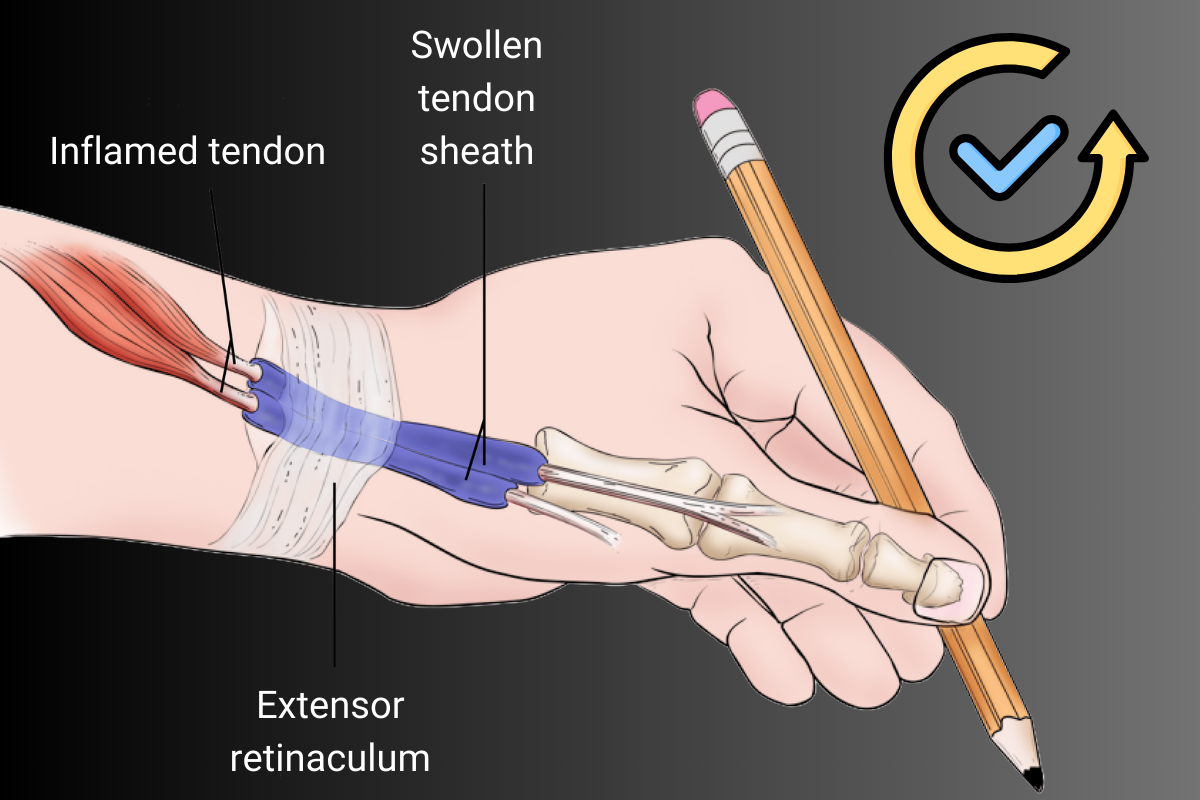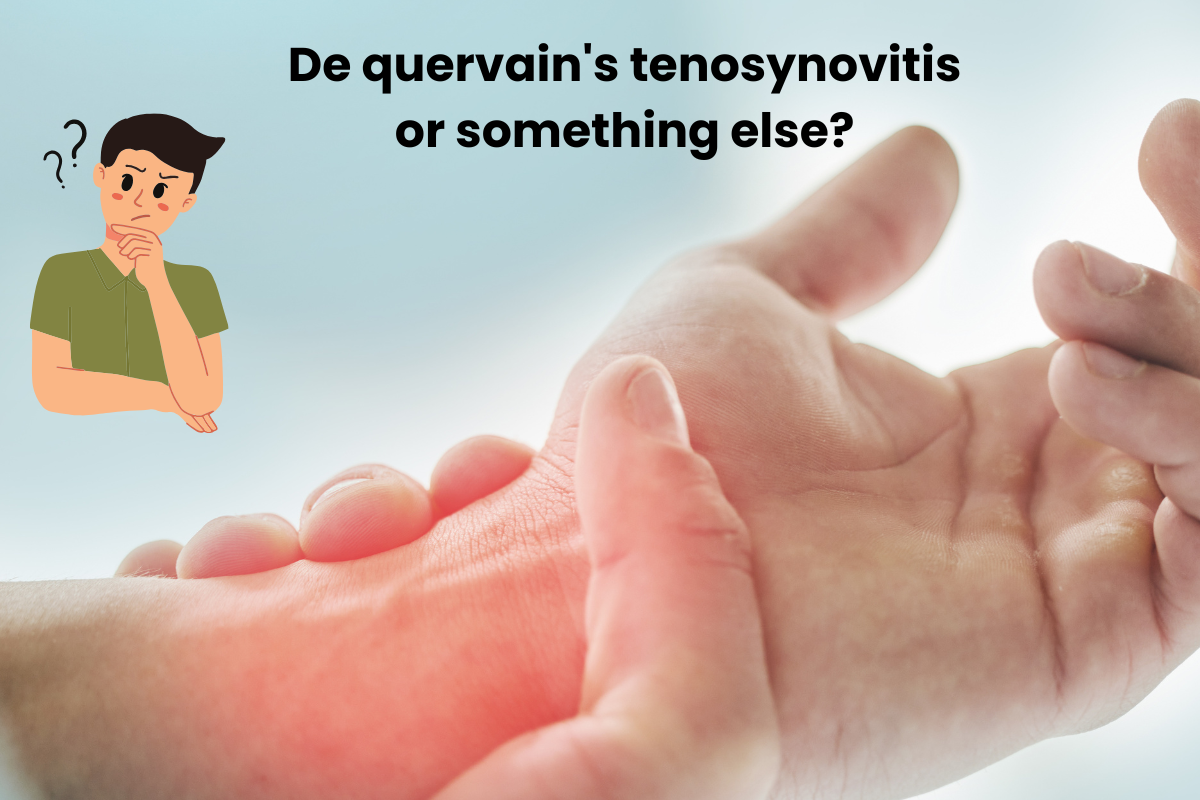- +91 75677 63301
- 24*7 Emergency Care
What to expect Before, During, and After De Quervain’s Release surgery?
- Home
- /
- De Quervain's Tenosynovitis
- /
- What to expect Before,...

De Quervain’s tenosynovitis is a painful condition affecting the tendons on the thumb side of your wrist. When non-surgical treatments such as splinting, anti-inflammatory medications, or corticosteroid injections no longer relieve symptoms, De Quervain’s release surgery may be recommended.
Table of Contents
ToggleBefore surgery: Consultation & Preparation
1. Diagnosis confirmation
Before scheduling surgery, your hand specialist will:
- Review your medical history and symptoms.
- Perform a physical exam. (such as Finkelstein’s test)
- Rule out other conditions like arthritis or carpal tunnel syndrome.
Your doctor will explain:
- The nature and goal of the surgery.
- Risks and benefits.
- Expected recovery time.
- Any lifestyle adjustments needed.
You may be advised to:
- Stop blood-thinning medications (e.g., aspirin) a few days before.
- Avoid food or drink 6–8 hours before the procedure if general anesthesia is used.
- Arrange for someone to drive you home post-surgery.
Most of De Quervain’s release surgeries are performed under.
- Local anesthesia. (numbs only the surgical site)
- Sometimes, regional or light sedation may be given.
2. The procedure
- A small incision (around 1–2 cm) is made over the thumb-side of the wrist.
- The surgeon identifies and releases the tight sheath (tunnel) encasing the inflamed tendons.
- This relieves pressure and allows the tendons to move freely.
3. Duration
The surgery typically takes 15 to 30 minutes and is done as a day-care procedure, meaning you can go home the same day.
After surgery: Recovery & Rehabilitation
1. Immediately after
- Your wrist will be bandaged.
- Mild swelling, soreness, or numbness is normal for a few days.
- Pain is managed with oral medications.
2. At-Home care
- Keep the hand elevated for 24–48 hours
- Follow dressing and wound care instructions
- Avoid lifting or straining activities for at least a week
3. Stitches and Scar care
- Stitches are usually removed within 10–14 days.
- A small scar may remain, but it typically fades over time.
4. Physical therapy
- Gentle hand and wrist exercises may be prescribed.
- Helps restore strength, flexibility, and function.
- Full recovery can take 4 to 6 weeks, depending on your healing response.
When to call your doctor?
Contact your healthcare provider if you experience:
- Increased pain, redness, or swelling at the incision site,
- Fever or chills,
- Difficulty moving your thumb or fingers,
Why choose Krisha Hand Hospital?
- Expertise in hand & Wrist surgery – Our team of highly skilled surgeons focuses exclusively on hand, wrist, and upper limb conditions, offering specialized care with excellent outcomes.
- Advanced surgical facilities – We are equipped with modern operation theatres, microsurgical instruments, and advanced imaging systems designed specifically for hand surgeries.
- Comprehensive care approach – From diagnosis and surgery to hand therapy and rehabilitation, we offer end-to-end care under one roof for a smooth recovery journey.
- Latest techniques & Treatments – We use advanced, minimally invasive techniques for conditions like nerve injuries, tendon problems, congenital differences, and more.
- Personalized and Compassionate care – Every patient is treated with empathy, clear communication, and tailored treatment plans to ensure the best possible recovery.
- Trusted by patients across the region – Known for our consistent results, we are a preferred destination for patients seeking expert hand and wrist care.
Conclusion
De Quervain’s release surgery is a safe and effective solution for patients who have not found relief through conservative treatments. By releasing the tight sheath around the tendons, this procedure can significantly reduce pain and restore function in your wrist and thumb — helping you return to everyday activities without discomfort.
At Krisha Hand Hospital in Ahmedabad , we combine surgical precision with compassionate care to ensure the best outcomes for every patient. From diagnosis to full recovery, our dedicated team is here to guide you through every step of your journey with expertise and personal attention.
If you’re experiencing persistent pain on the thumb side of your wrist, don’t wait. Schedule a consultation with our specialists today and take the first step toward pain-free movement and a better quality of life.
Author bio
Dr. Karn Maheshwari is the founder of Krisha Hand Hospital, Ahmedabad, established in 2016. He is the only fnb-qualified hand surgeon across Gujarat, Rajasthan, and Madhya Pradesh.
With MS and DNB in orthopedics, Dr. Maheshwari specializes in treating a wide range of hand and wrist conditions, including carpal tunnel syndrome, sports hand injuries, orthopedic hand surgery, ganglion cysts, mangled hand injuries, congenital hand differences, brachial plexus palsy, cerebral palsy & spastic hand, hand tendinopathy, hand microsurgery, hand swelling, hand transplants, hand reimplantation, rheumatoid hand deformities, and peripheral nerve injuries & compressive neuropathies.
Dr. Maheshwari’s unmatched expertise and patient-centric approach ensure world-class treatment, advanced surgical solutions, and optimal recovery for patients with complex hand and wrist conditions.
FAQs
While some mild cases may improve with rest and conservative treatment, untreated moderate to severe cases can lead to chronic pain, decreased thumb mobility, and difficulty with daily hand function.
Recurrence is rare but possible, especially if the patient returns too early to repetitive wrist or thumb activities without proper rehabilitation.
Most patients do not require a full cast. A light dressing or splint may be applied for a few days post-surgery to support the wrist and reduce swelling.
You should avoid driving immediately after surgery, especially while the wrist is bandaged or if you are taking pain medications. Most patients can resume driving after a few days, depending on pain levels and hand mobility.
In most cases, grip strength and thumb function improve significantly after recovery. However, some patients may experience temporary weakness or stiffness that improves with physiotherapy.
Yes, in most cases, this surgery is covered under standard health insurance policies. It’s best to check with your insurance provider or hospital billing team for specific coverage details.
Avoid lifting heavy objects, repetitive wrist/thumb movements, or contact sports for at least 4–6 weeks or as advised by your surgeon or therapist.



